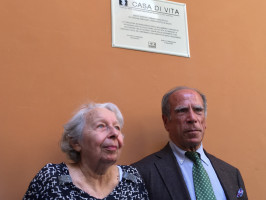Dozens of healthy young Jews were hospitalized with the fictitious ‘K syndrome’ in isolated ward to protect them from Nazis.
 The Coliseum forms the background as a contingent of German Hitler Youth, carrying a Nazi banner, march through ancient Rome in Sept. 28 1936.
The Coliseum forms the background as a contingent of German Hitler Youth, carrying a Nazi banner, march through ancient Rome in Sept. 28 1936.Between September 1943 and June 1944, coinciding with the Nazi occupation of the city, Rome was struck by a mysterious epidemic. A previously unknown and highly contagious disease, the “K syndrome,” forced a local hospital to isolate dozens of infected patients in a special wing, completely inaccessible to outsiders – especially German soldiers.
If you never heard of the “K syndrome,” that’s because it’s not a real disease. In fact, it was a fictitious illness completely made up by the Fatebenefratelli hospital in order to keep dozens of Roman Jews safe from the Nazis who were hunting them down (the letter “K” was a reference to Albert Kesselring, the German officer in charge of the Italian capital).
Adriano Ossicini, back then a young doctor, came up with the idea and the other staff played along. With this creative trick they saved at least 40 lives. More than a thousand Roman Jews were arrested and deported to death camps – only a handful of them survived.
The Fatebenefratelli was recently marked as “Houses of Life,” or officially recognized as a place offering shelter to victims of the Nazi persecution, by the Raoul Wallenberg Foundation, an American NGO raising awareness on Holocaust rescuers. The hospital – which, based in the Tiber island, is just a few hundred meters away from the Jewish Ghetto – celebrated the recognition on Tuesday with a ceremony attended by Ossicini himself, now a 96-year-old retired psychiatrist, and one of the people he contributed to saving, the 83-year-old Luciana Tedesco, who was just a small girl when she was hospitalized as a fictitious patient.
Representatives of the city’s Jewish community and of the Shoah Museum Foundation, an organization in Rome promoting Holocaust education, also attended the ceremony and thanked the Fatebenefratelli for its role.
 Gabriele Sonnino and Luciana Tedesco, two of the Jews rescued by the Fatebenefratelli hospital, in front of the new commemorative plaque marking the Fatebenefratelli hospital as House of Life. Franco Ilardo.
Gabriele Sonnino and Luciana Tedesco, two of the Jews rescued by the Fatebenefratelli hospital, in front of the new commemorative plaque marking the Fatebenefratelli hospital as House of Life. Franco Ilardo.While stories of doctors and nurses saving Jews during World War II are not unheard of, “there are at least two issues that make the case of the Fatebenefratelli really impressive,” Mario Venezia of the Shoah Museum Foundation told Haaretz. “To begin with, the inventiveness behind it is really unique – Ossicini came up with a brilliant idea. Then, the solidarity of the staff played a crucial role. It’s very impressive how everyone played along with the lie. If one single doctor or nurse had defected and called the Germans, the whole plan would not have worked.”
In a video interview with the La Stampa daily, Ossicini explained that he originally came up with the idea of the fictitious syndrome just to make the Jews’ presence in the hospital more believable: “We had to disguise them as patients. So, even though they were healthy, we had to write something on their medical records, and I thought of making up an illness. This way, it would be clear to all doctors and nurses that they didn’t need any medication, while outsiders wouldn’t be able to guess their identity.”
Only when the Germans started suspecting Jews might be hiding in the hospital did Ossicini think of passing the word that the “K syndrome” was deadly – and highly infectious. “We were telling [Nazis officers] to be careful, not to go to that wing or they might catch the disease. Since they weren’t neither particularly smart nor very brave, it was easy to scare the Nazis off,” he recalls.

